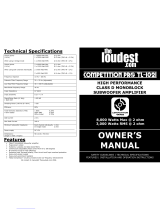
13
Audio Output Section
The audio output sections of the Class D RVA-M Series ampliers feature fast switching MOSFETs.
Power and Protection Circuitry
RVA-M Series ampliers feature our unique IC-controlled protection circuitry. This sophisticated circuit constantly monitors the heat sink internal temperature and various voltages,
adjusting the amp automatically and protecting it from dangerous conditions. The LED located on the side of the amplier provides indication of the amplier status. The LED will light
green when the amplier is receiving proper power, ground, and remote voltages, and the IC-monitoring sequence indicates the amp is functional. In case the amplier encounters a
diagnostic condition as listed below, the LED will light red indicating a diagnostic condition. When a diagnostic condition is sensed, the amplier will go into a self-preservation mode. If
the cause of the diagnostic condition is not corrected, it will eventually shut down. There are certain critical diagnostic conditions that will turn the amplier off immediately.
Thermal Protection: When the amplier reaches an unsafe operating temperature of 80 degrees Celsius, the amplier will turn off. Once the amplier cools down to a safe temperature,
it will automatically turn on again. If you live in a hot climate, we suggest installing additional cooling fans in your trunk to exhaust the hot air that can build up in the trunk this will help
keep the ambient temperature in the trunk as low as possible so that your amps work awlessly and without any musical interruption.
Speaker Short-Circuit Protection: Should your speakers short-circuit due to voice coil burnout, or should the amplier sense an impedance too low to handle, the Protection LED will
light, indicating a diagnostic condition. Turn off your system, disconnect one speaker at a time and try to determine which speaker might be faulty. Correct the condition and restart
the amplier. You must reset the amplier by turning it OFF and then ON again by the Remote power connection after correcting a diagnostic condition. (Turn your radio off and then
on again.) Clipping or total shutdown may also be a result of a bad ground connection or loose ground. If you nd that your speakers and speaker wires are not shorted, please check
your ground and power connections.
Input Overload Protection: This circuit will either shut down the amplier completely or make the amplier spurt on and off, indicating that it is in a diagnostic condition. Turn the system
off and reduce the gain on the amplier or volume from your head unit; this should result in a corrected condition.
DC Offset Protection: Should any DC voltage try to enter the amplier via the speaker terminals, it will cause the amplier to shut down and not operate until this condition is remedied.
This circuit will also protect damaging high DC voltages from reaching your speakers should your amplier ever malfunction.
You must reset the amplier by turning it OFF and then ON again after correcting a diagnostic condition (turn your radio off and then on again). If the amplier stays in protection after
a reset, it is most likely faulty.
To reset the amplifier, you must first diagnose what caused the problem, correct the fault, and restart the system.
Mute Circuit
This is an anti-thump, mute-and-delay circuit that eliminates irritating, speaker-damaging, turn-on and turn-off transients normally experienced with less expensive ampliers.
Bass Remote
The dash-mounted bass remote allows you to control the amplier’s bass level from the comfort of the driver’s seat. It features a power LED indicator, which indicates the unit is receiving
power and operating nominally.
Features






















